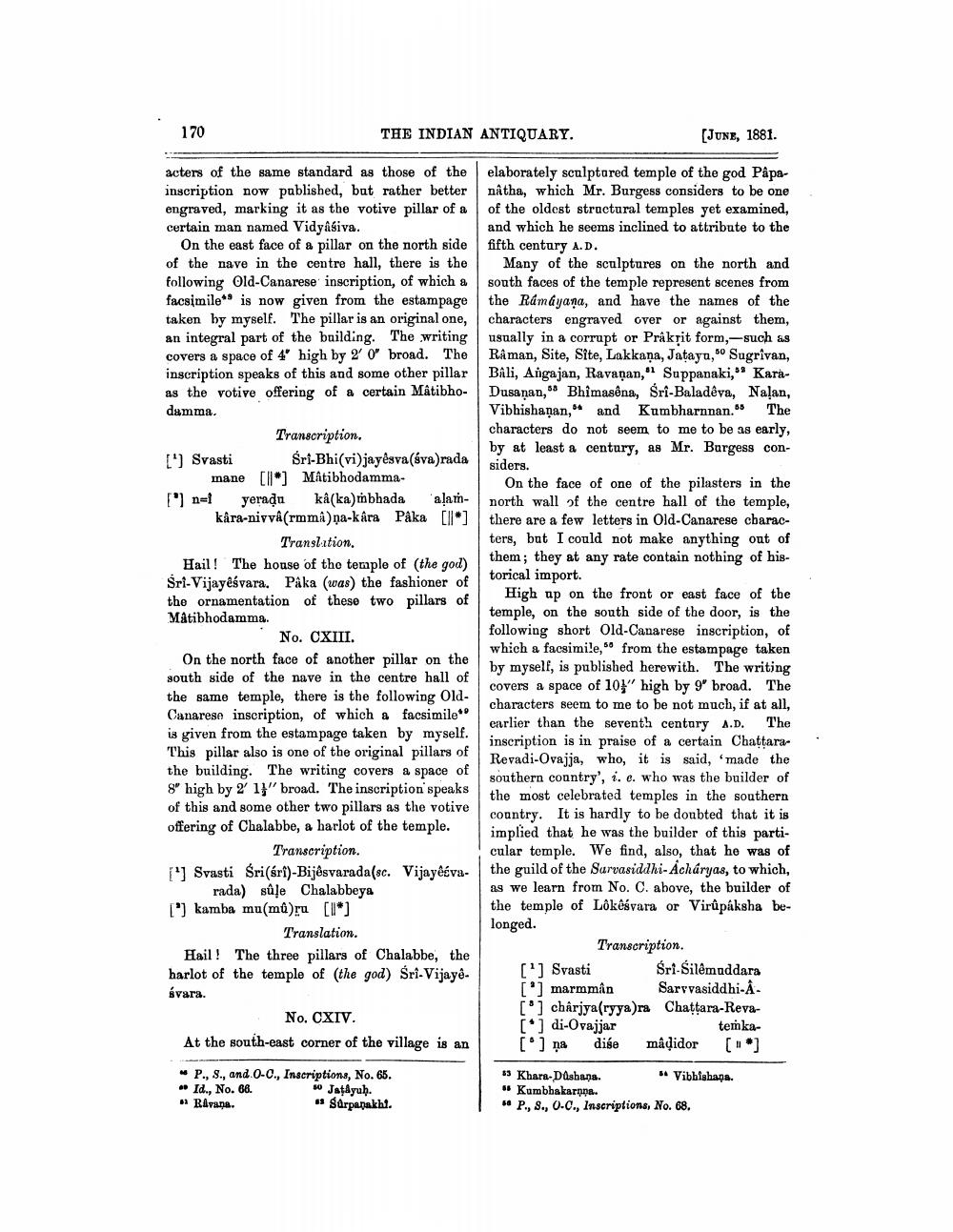________________
170
acters of the same standard as those of the inscription now published, but rather better engraved, marking it as the votive pillar of a certain man named Vidyâśiva.
On the east face of a pillar on the north side of the nave in the centre hall, there is the following Old-Canarese inscription, of which a facsimile is now given from the estampage taken by myself. The pillar is an original one, an integral part of the building. The writing covers a space of 4" high by 2' 0" broad. The inscription speaks of this and some other pillar as the votive offering of a certain Mâtibhodamma.
Transcription.
THE INDIAN ANTIQUARY.
['] Svasti
Bel-Bhi(vi)jaylava(áva)rada mane [*] Mâtibhodamma
[*] n=1 yeraḍu kâ(ka)mbhada alamkâra-nivvâ(rmma) pa-kâra Pâka [*]
Translation.
Hail! The house of the temple of (the god)
Sri-Vijayêśvara. Pâka (was) the fashioner of the ornamentation of these two pillars of Mâtibhodamma.
On the face of one of the pilasters in the north wall of the centre hall of the temple, there are a few letters in Old-Canarese characters, but I could not make anything out of them; they at any rate contain nothing of his
torical import.
High up on the front or east face of the temple, on the south side of the door, is the following short Old-Canarese inscription, of which a facsimile," from the estampage taken
by myself, is published herewith. The writing covers a space of 10" high by 9" broad. The characters seem to me to be not much, if at all, earlier than the seventh century A.D. The inscription is in praise of a certain ChaṭṭaraRevadi-Ovajja, who, it is said, 'made the southern country', i. e. who was the builder of the most celebrated temples in the southern country. It is hardly to be doubted that it is implied that he was the builder of this particular temple. We find, also, that he was of
Transcription.
[] Svasti Sri (śri)-Bijêsvarada(sc. Vijayêéva- the guild of the Sarvasiddhi-Acharyas, to which,
rada) sûle Chalabbeya
as we learn from No. C. above, the builder of the temple of Lôkêśvara or Virupaksha belonged.
Transcription.
No. CXIII.
On the north face of another pillar on the south side of the nave in the centre hall of the same temple, there is the following OldCanarese inscription, of which a facsimile** is given from the estampage taken by myself. This pillar also is one of the original pillars of the building. The writing covers a space of 8" high by 2' 1" broad. The inscription speaks of this and some other two pillars as the votive offering of Chalabbe, a harlot of the temple.
[] kamba mu(mů)ru [*]
Translation.
Hail! The three pillars of Chalabbe, the harlot of the temple of (the god) Sri-Vijayê
śvara.
No. CXIV.
At the south-east corner of the village is an
P., S., and O-C., Inscriptions, No. 65.
Id., No. 66.
Ravana.
[JUNE, 1881.
elaborately sculptured temple of the god Pâpanåtha, which Mr. Burgess considers to be one of the oldest structural temples yet examined, and which he seems inclined to attribute to the fifth century A.D.
Many of the sculptures on the north and south faces of the temple represent scenes from the Ramayana, and have the names of the characters engraved over or against them, usually in a corrupt or Prâkrit form,-such as Raman, Site, Site, Lakkana, Jatayu,50 Sugrîvan, Bâli, Angajan, Ravanan," Suppanaki," KaraDusanan, Bhimasêna, Śrî-Baladêva, Nalan, Vibhishanan, and Kumbharnnan.55 The characters do not seem to me to be as early, by at least a century, as Mr. Burgess considers.
53
so Jatayuh. ss Surpanakhi.
54
[1] Svasti Śri-Silêmuddara [*] marmmân Sarvvasiddhi-A[] chârjya(ryya)ra Chaṭṭara-Reva[*] di-Ovajjar temka[*] na dise mâdidor [*]
53 Khara-Dushana. "Kumbhakarna.
P., S., O-C., Inscriptions, No. 68.
Vibhishapa.




